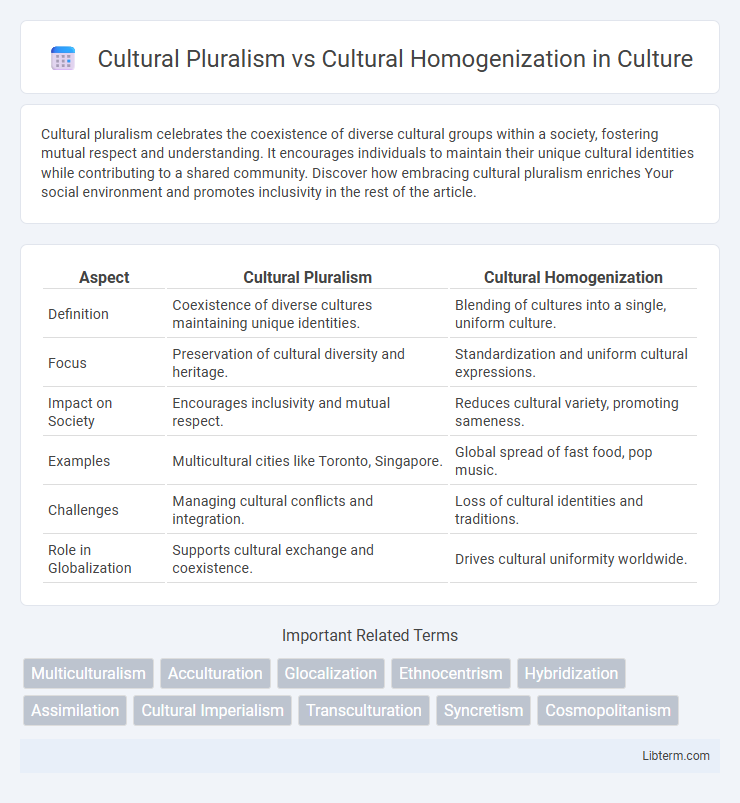Cultural pluralism celebrates the coexistence of diverse cultural groups within a society, fostering mutual respect and understanding. It encourages individuals to maintain their unique cultural identities while contributing to a shared community. Discover how embracing cultural pluralism enriches Your social environment and promotes inclusivity in the rest of the article.
Table of Comparison
| Aspect | Cultural Pluralism | Cultural Homogenization |
|---|---|---|
| Definition | Coexistence of diverse cultures maintaining unique identities. | Blending of cultures into a single, uniform culture. |
| Focus | Preservation of cultural diversity and heritage. | Standardization and uniform cultural expressions. |
| Impact on Society | Encourages inclusivity and mutual respect. | Reduces cultural variety, promoting sameness. |
| Examples | Multicultural cities like Toronto, Singapore. | Global spread of fast food, pop music. |
| Challenges | Managing cultural conflicts and integration. | Loss of cultural identities and traditions. |
| Role in Globalization | Supports cultural exchange and coexistence. | Drives cultural uniformity worldwide. |
Introduction to Cultural Pluralism and Cultural Homogenization
Cultural pluralism emphasizes the coexistence of diverse cultural groups within a society, fostering mutual respect and maintaining distinct cultural identities. Cultural homogenization refers to the process where local cultures are absorbed into a dominant global culture, often driven by globalization and mass media. Understanding these concepts is crucial for analyzing the impact of global interconnectedness on cultural diversity and social dynamics.
Defining Cultural Pluralism: Embracing Diversity
Cultural pluralism is defined as a societal framework where diverse cultural groups coexist with mutual respect and equal recognition, fostering an environment of inclusivity and shared values. It emphasizes the preservation of distinct ethnic identities, languages, and traditions within a unified social structure, promoting intercultural dialogue and understanding. This approach counters cultural homogenization by valuing multicultural contributions and encouraging dynamic interactions among varied cultural expressions.
Understanding Cultural Homogenization: The Push for Uniformity
Cultural homogenization refers to the process by which local cultures are transformed or absorbed by dominant outside influences, leading to reduced cultural diversity and uniformity in cultural expressions worldwide. This push for uniformity is often driven by globalization, media, multinational corporations, and technological advancement, promoting standardized consumer products, entertainment, and lifestyles. Understanding cultural homogenization involves recognizing its impact on indigenous traditions, languages, and social norms, which face erosion as global culture imposes a more uniform identity.
Historical Roots of Cultural Pluralism
Cultural pluralism traces its historical roots to ancient civilizations where diverse ethnic groups coexisted within empires, such as the Persian, Roman, and Ottoman Empires, fostering cultural diversity and exchange. Philosophical foundations emerged during the Enlightenment, emphasizing coexistence, tolerance, and the value of multiple cultural identities within a society. These historical precedents form the basis for modern multicultural policies that resist cultural homogenization by promoting the preservation and appreciation of distinct cultural heritages.
Globalization’s Role in Cultural Homogenization
Globalization significantly accelerates cultural homogenization by promoting widespread adoption of dominant cultural practices, languages, and consumer products across diverse regions. Multinational corporations and global media platforms disseminate uniform cultural norms, leading to a reduction in local cultural distinctiveness. This process often results in diminished cultural pluralism as traditional customs and indigenous identities face erosion under global cultural convergence.
Social Benefits of Cultural Diversity
Cultural pluralism enhances social cohesion by fostering mutual respect and understanding among diverse communities, leading to increased creativity and innovation. Societies embracing cultural diversity experience broader economic growth and improved problem-solving abilities due to diverse perspectives. Maintaining cultural differences supports social equity and reduces xenophobia, promoting inclusive policies and peaceful coexistence.
Challenges Posed by Cultural Homogenization
Cultural homogenization challenges social diversity by promoting uniform cultural expressions that often overshadow indigenous traditions and local identities. The spread of dominant global cultures, driven by media, technology, and multinational corporations, risks eroding unique languages, customs, and practices, leading to cultural loss. This process creates resistance among communities striving to preserve their heritage, highlighting conflicts between global integration and cultural preservation.
Case Studies: Pluralism vs Homogenization in Practice
Case studies of cultural pluralism demonstrate the preservation of diverse languages, traditions, and social practices within multicultural societies like Canada and India, fostering inclusivity and intercultural dialogue. In contrast, instances of cultural homogenization are evident in globalized urban centers such as Tokyo and New York, where dominant cultural norms and consumerism often overshadow indigenous customs, leading to a loss of unique cultural identities. These contrasting case studies highlight the tension between maintaining cultural diversity and the forces of globalization driving uniformity.
Policy Implications and Approaches
Policy approaches to cultural pluralism emphasize protecting minority rights, promoting multilingual education, and fostering inclusive governance to maintain diversity and social cohesion. In contrast, policies supporting cultural homogenization often focus on standardized curricula, national identity promotion, and assimilation programs, which may undermine cultural distinctiveness. Balancing these approaches requires adaptable frameworks that encourage intercultural dialogue while respecting individual cultural expressions.
The Future of Cultural Identities in a Globalized World
Cultural pluralism promotes the coexistence of diverse cultural identities, fostering innovation and mutual respect in a globalized world where interconnectedness intensifies. Cultural homogenization risks diminishing unique traditions and languages, leading to a loss of cultural heritage as dominant global influences spread. The future of cultural identities depends on balancing global integration with the preservation and revitalization of local customs, ensuring vibrant, resilient communities.
Cultural Pluralism Infographic

 libterm.com
libterm.com